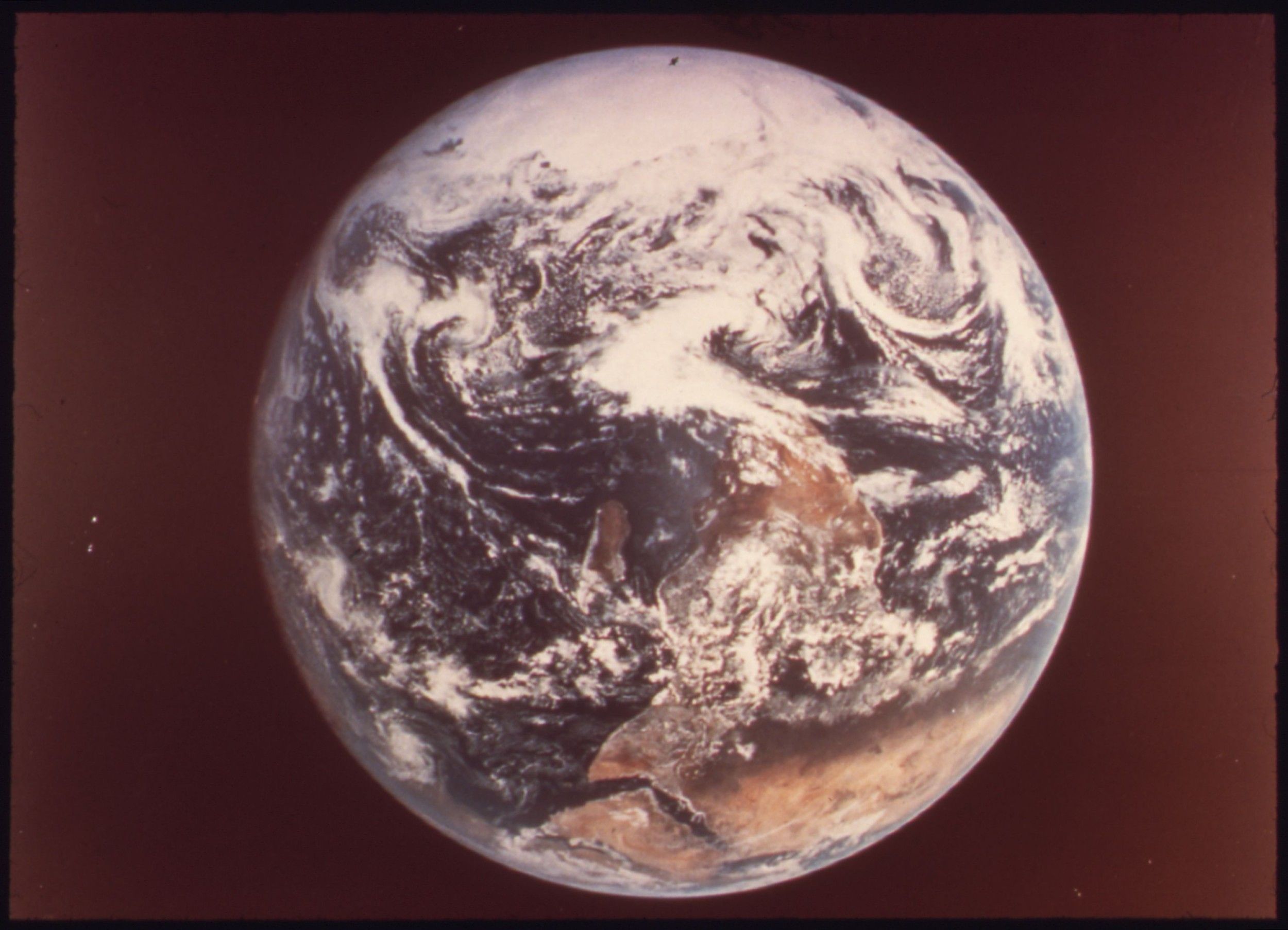Landing a Man on the Moon: President Nixon and the Apollo Program
Making Connections
All documents and text associated with this activity are printed below, followed by a worksheet for student responses.Introduction
Who was President when Astronaut Neil Armstrong first walked on the Moon? And who was President during Apollo 17, America's last lunar mission?If you answered President Nixon, you are correct. The artifacts in this activity document the birth of the Apollo program, the triumph of Apollo 11, and what many consider the end of the Space Race.
Carefully study each step to answer the questions and learn more our Nation's quest to land a man on the Moon.
Name:
Class:
Class:
Worksheet
Landing a Man on the Moon: President Nixon and the Apollo Program
Making Connections
Examine the documents and text included in this activity. Fill in any blanks in the sequence with your thoughts and write your conclusion response in the space provided.On May 25, 1961, President John F. Kennedy famously urged the nation to work together toward, "achieving the goal, before this decade is out, of landing a man on the Moon and returning him safely to the Earth. No single space project in this period will be more impressive to mankind, or more important for the long-range exploration of space; and none will be so difficult or expensive to accomplish."
Just over nine years later, American citizens, along with much of the world, watched as Apollo 11 Astronaut Neil Armstrong took his first steps on the Moon on July 20, 1969.
How did this dream become a reality? Which Presidents played a role in the success? What was accomplished in Apollo missions 1-10 and what happened after Apollo 11?
Follow the document trail to learn more about President Nixon and America's lunar legacy. Record your answers to the questions as you go.
Just over nine years later, American citizens, along with much of the world, watched as Apollo 11 Astronaut Neil Armstrong took his first steps on the Moon on July 20, 1969.
How did this dream become a reality? Which Presidents played a role in the success? What was accomplished in Apollo missions 1-10 and what happened after Apollo 11?
Follow the document trail to learn more about President Nixon and America's lunar legacy. Record your answers to the questions as you go.
Based on President Kennedy's speech and the government report that you will see in the next two boxes:
1) Do you think that the United States or the Soviet Union was winning the Space Race when Kennedy issued his national challenege to land a man on the Moon?
2) Why did President Kennedy think the Moon landing was important?
1) Do you think that the United States or the Soviet Union was winning the Space Race when Kennedy issued his national challenege to land a man on the Moon?
2) Why did President Kennedy think the Moon landing was important?
Memoranduam for President Subject: Evaluation of Space Program April 28, 1961

Rice University Speech September 12, 1962
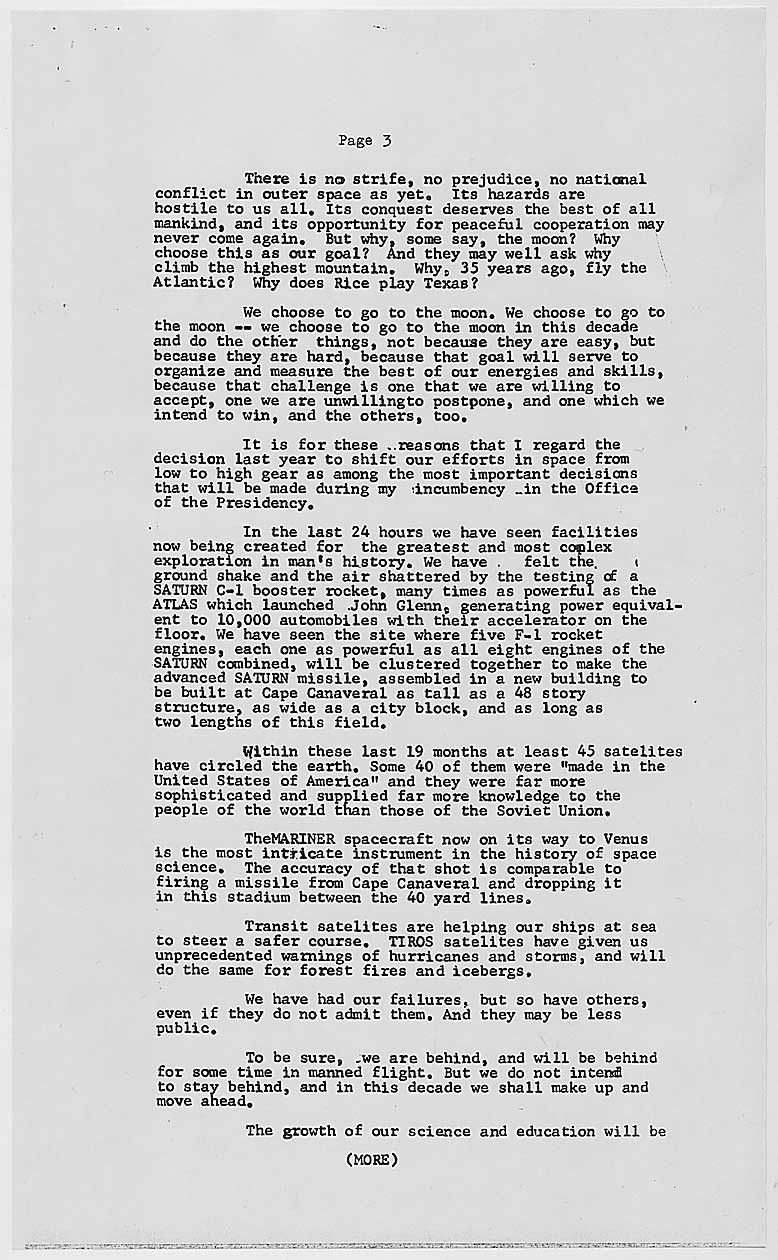
3) Based on the next box, what happened to the first Apollo mission?
Memorandum from Jim Jones to President Johnson about the Fire on Apollo 1
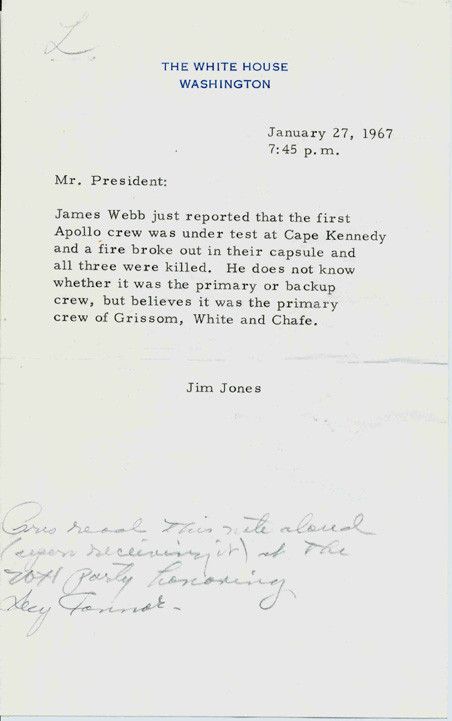
4) Based on the next two boxes, what significant feat did Apollo 8 accomplish?
Debrief: Apollo 8
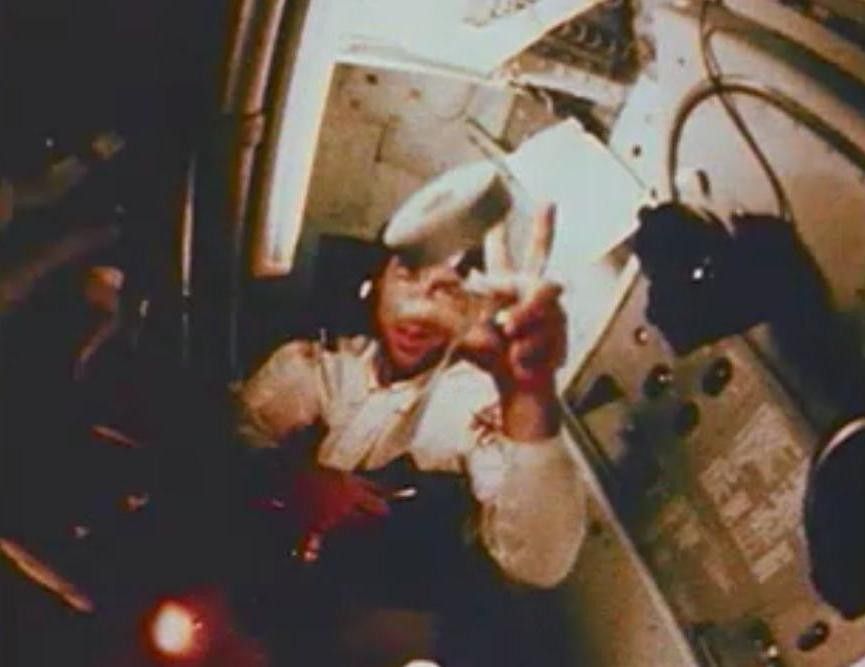
Photograph of Apollo 8's View of the Moon

5) Based on the next box, what was the goal of Apollo 10?
Map of the Lunar Surface

6) Based on the next two boxes, how did the Apollo 11 astronauts prepare for the Moon landing?
Apollo 11 Flight Plan
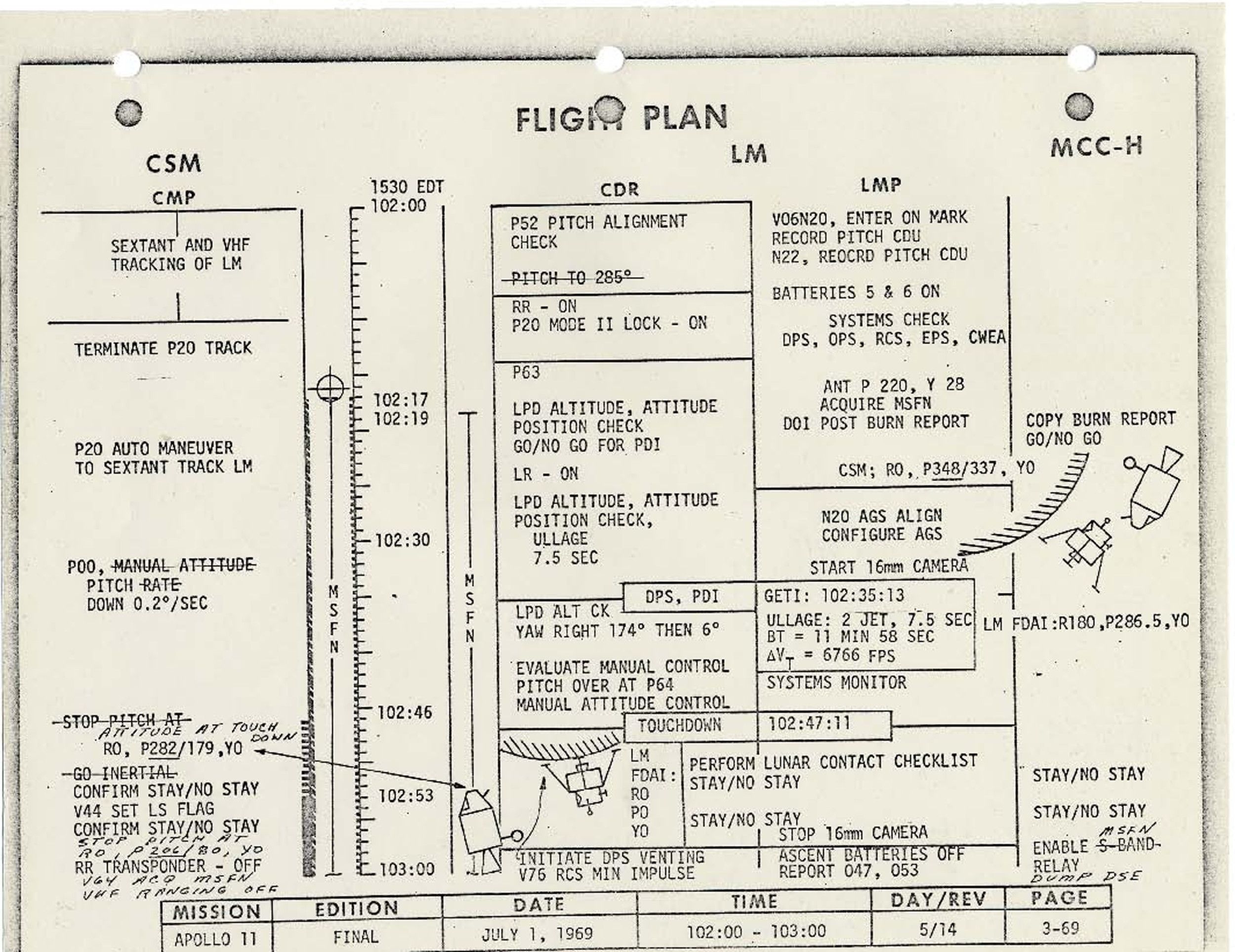
Apollo 11 Target of Opportunity Flight Chart

Photograph of Astronaut Edwin E. (Buzz) Aldrin, Jr. Posing on the Moon Next to the U.S. Flag
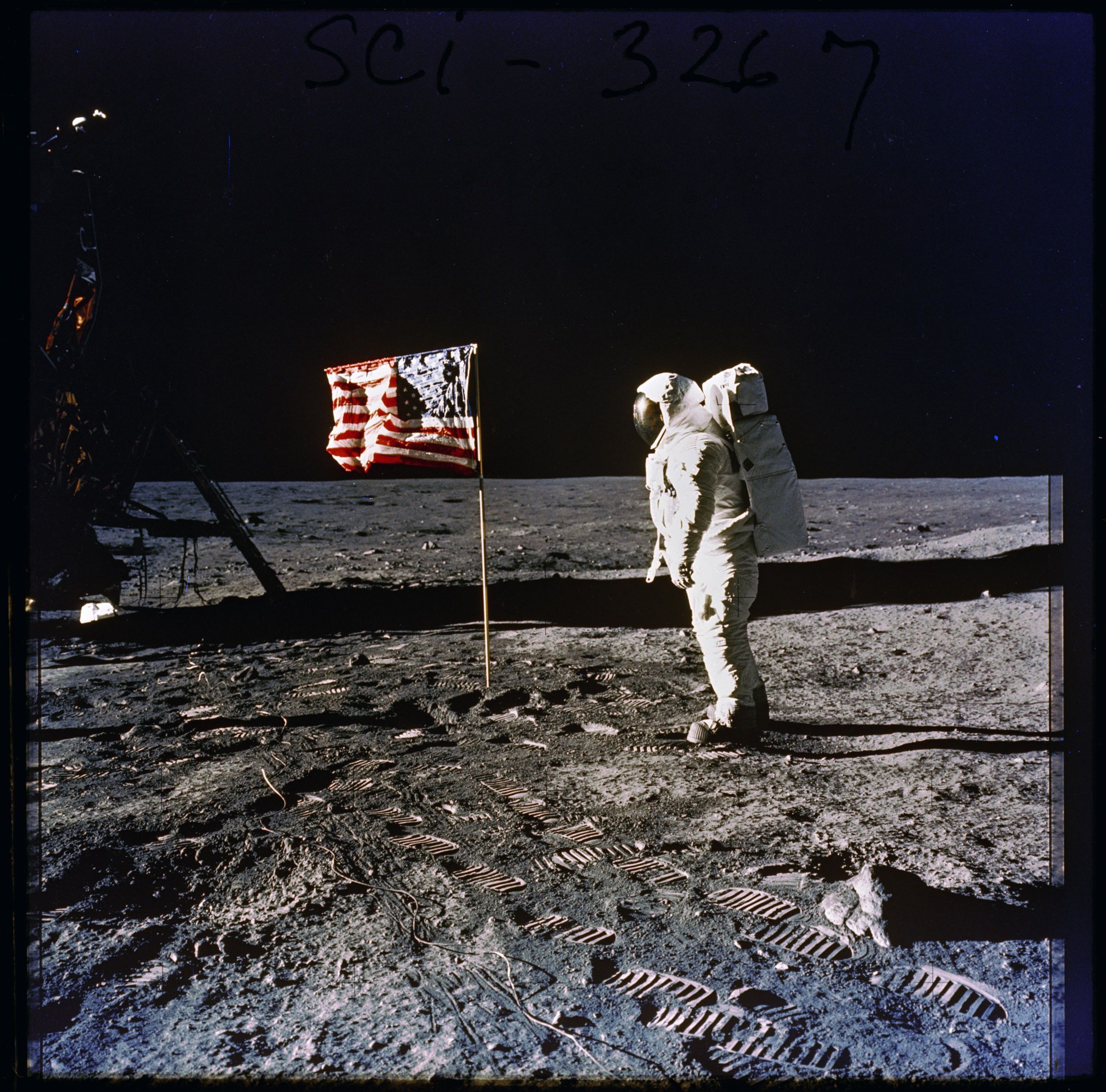
7) Based on the next two boxes, how did President Nixon congratulate the Apollo 11 astronauts?
Presidential Daily Diary Entry

Richard M. Nixon on the phone in the oval office talking to Astronaunts on the moon
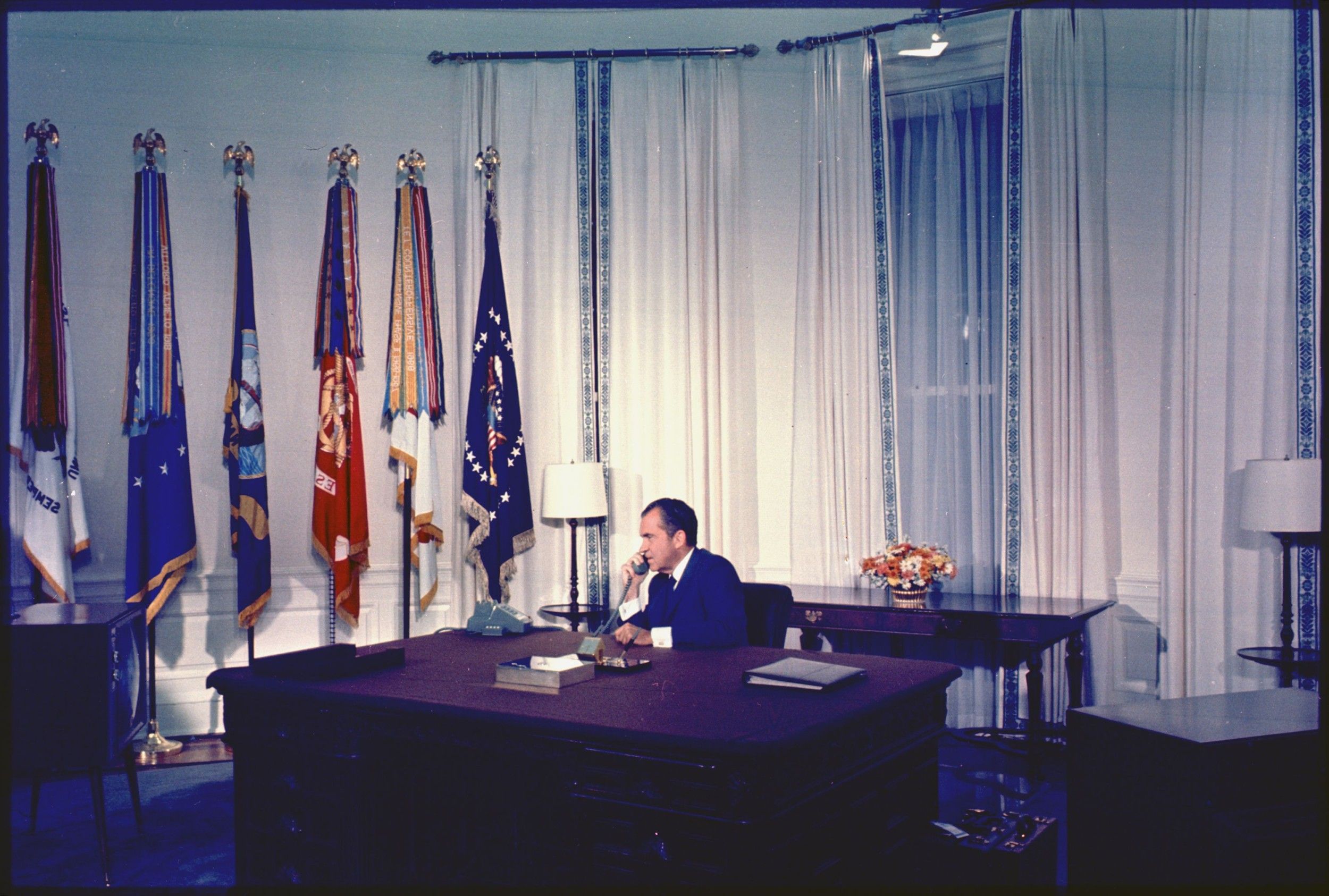
8) Based on the next three boxes, how did Americans react to the success of Apollo 11?
Letter from Thaddeus A. Zagorewicz to President Richard Nixon
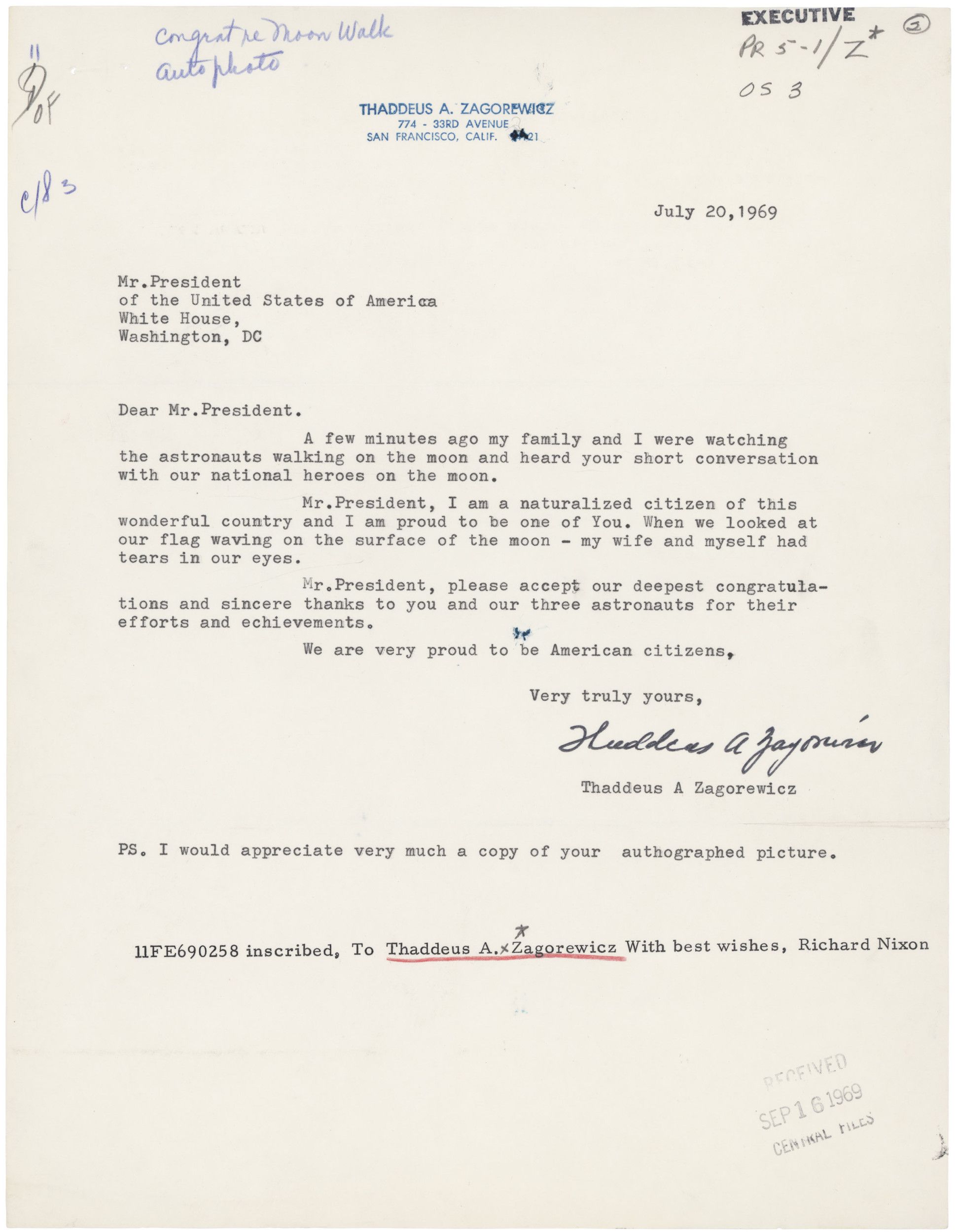
Postcard with Apollo 11 Commemorative First Day Issue Stamp and Signatures
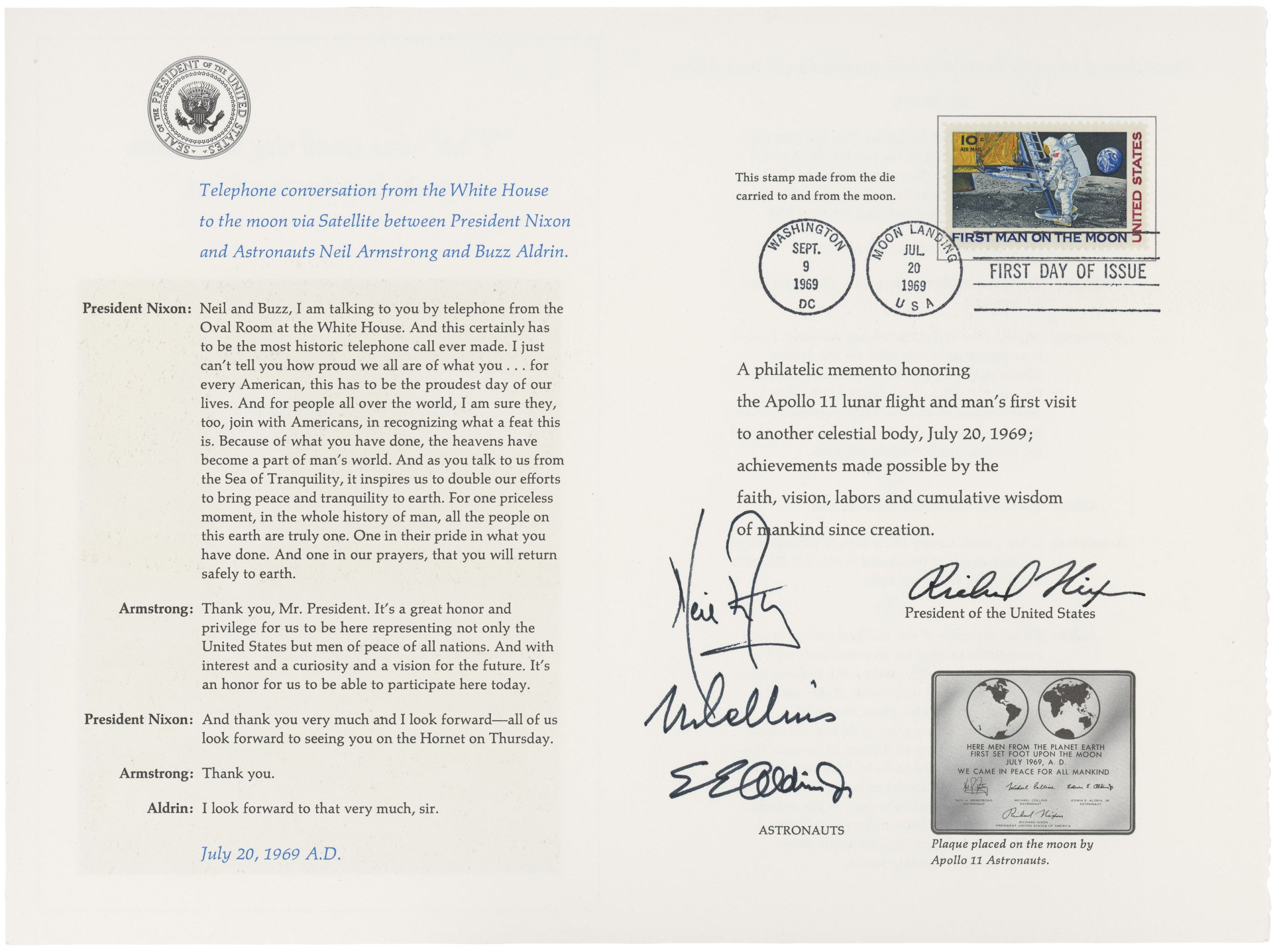
S. 2709 Authorizing the Erection of a Statue to Commemorate the Manned Lunar Landing and the Placing of the United States Flag on the Moon
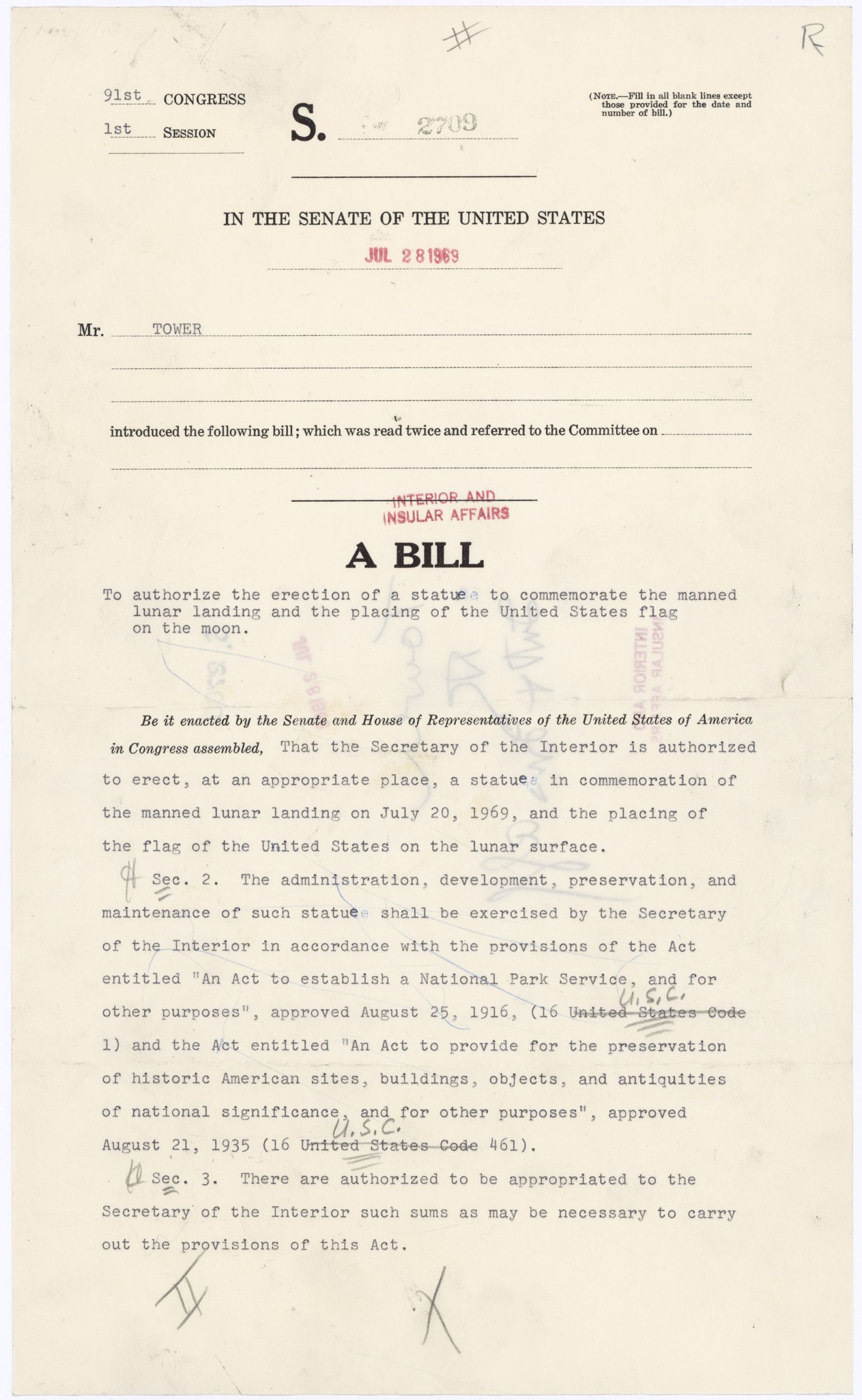
Based on the last box and your knowledge of history:
9) What was the last lunar mission?
10) Who was President at the time?
9) What was the last lunar mission?
10) Who was President at the time?
Earth, as Seen by Astronauts Eugen Cernan, Ronald Evans and Harrison Schmidt from Apollo 17
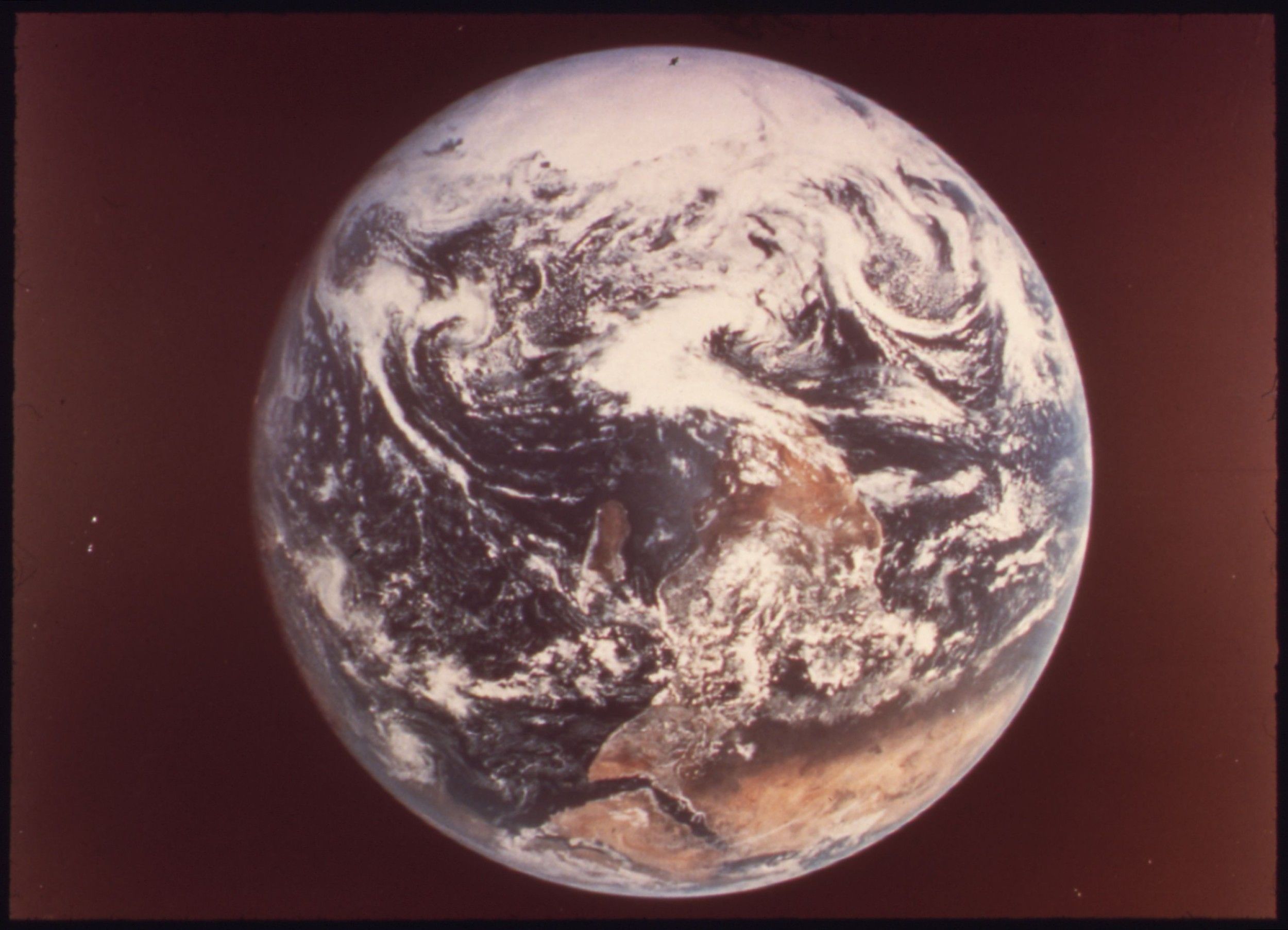
1
Activity Element
Memoranduam for President Subject: Evaluation of Space Program April 28, 1961
Page 1

2
Activity Element
Rice University Speech September 12, 1962
Page 3

3
Activity Element
Memorandum from Jim Jones to President Johnson about the Fire on Apollo 1
Page 1

4
Activity Element
Debrief: Apollo 8
Page 1

5
Activity Element
Photograph of Apollo 8's View of the Moon
Page 1

6
Activity Element
Map of the Lunar Surface
Page 1

7
Activity Element
Apollo 11 Flight Plan
Page 1

8
Activity Element
Apollo 11 Target of Opportunity Flight Chart
Page 1

9
Activity Element
Photograph of Astronaut Edwin E. (Buzz) Aldrin, Jr. Posing on the Moon Next to the U.S. Flag
Page 1

10
Activity Element
Presidential Daily Diary Entry
Page 1

11
Activity Element
Richard M. Nixon on the phone in the oval office talking to Astronaunts on the moon
Page 1

12
Activity Element
Letter from Thaddeus A. Zagorewicz to President Richard Nixon
Page 1

13
Activity Element
Postcard with Apollo 11 Commemorative First Day Issue Stamp and Signatures
Page 2

14
Activity Element
S. 2709 Authorizing the Erection of a Statue to Commemorate the Manned Lunar Landing and the Placing of the United States Flag on the Moon
Page 1

15
Activity Element
Earth, as Seen by Astronauts Eugen Cernan, Ronald Evans and Harrison Schmidt from Apollo 17
Page 1

Conclusion
Landing a Man on the Moon: President Nixon and the Apollo Program
Making Connections
No one on Earth has visited the Moon since Apollo 17 left the lunar soil in December 1972.- What compelled the Space Race of the 1960s and 1970s?
- Why do you think it came to an end?
- Do you think the United States should go back to the Moon?
Your Response
Document
Memoranduam for President Subject: Evaluation of Space Program April 28, 1961
04/28/1961
Lyndon Johnson's response to President Kennedy's memorandum of April 20, 1961 asking for an evaluation of the U. S. Space Program.
This primary source comes from the Collection JFK-POF: Papers of John F. Kennedy: President's Office Files.
National Archives Identifier: 193857
Full Citation: Memoranduam for President Subject: Evaluation of Space Program April 28, 1961; 04/28/1961; Collection JFK-POF: Papers of John F. Kennedy: President's Office Files, . [Online Version, https://www.docsteach.org/documents/document/memoranduam-for-president-subject-evaluation-of-space-program-april-28-1961, April 19, 2024]Memoranduam for President Subject: Evaluation of Space Program April 28, 1961
Page 1
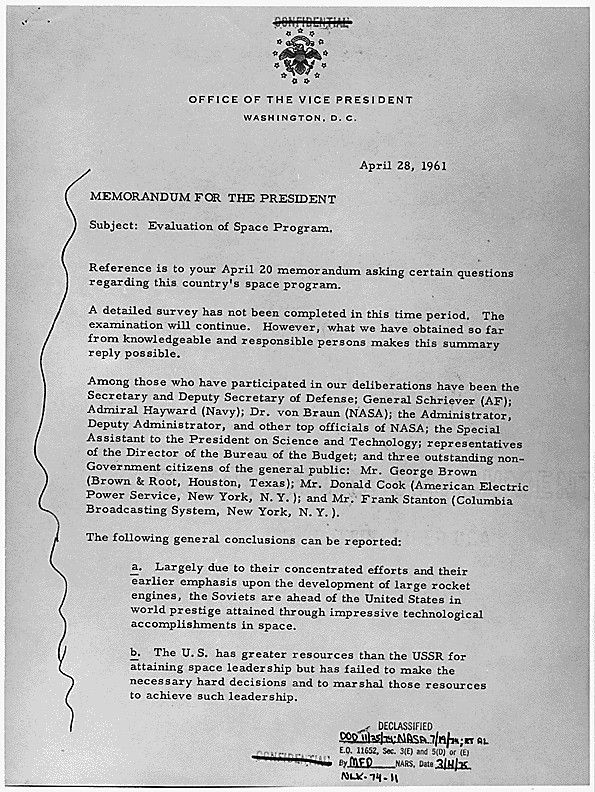
Memoranduam for President Subject: Evaluation of Space Program April 28, 1961
Page 2

Memoranduam for President Subject: Evaluation of Space Program April 28, 1961
Page 3

Memoranduam for President Subject: Evaluation of Space Program April 28, 1961
Page 4
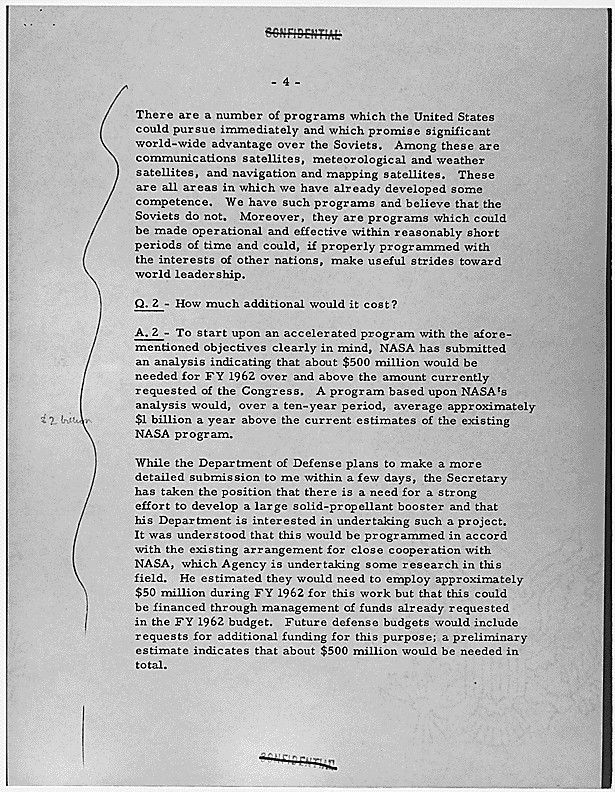
Memoranduam for President Subject: Evaluation of Space Program April 28, 1961
Page 5

Memoranduam for President Subject: Evaluation of Space Program April 28, 1961
Page 6
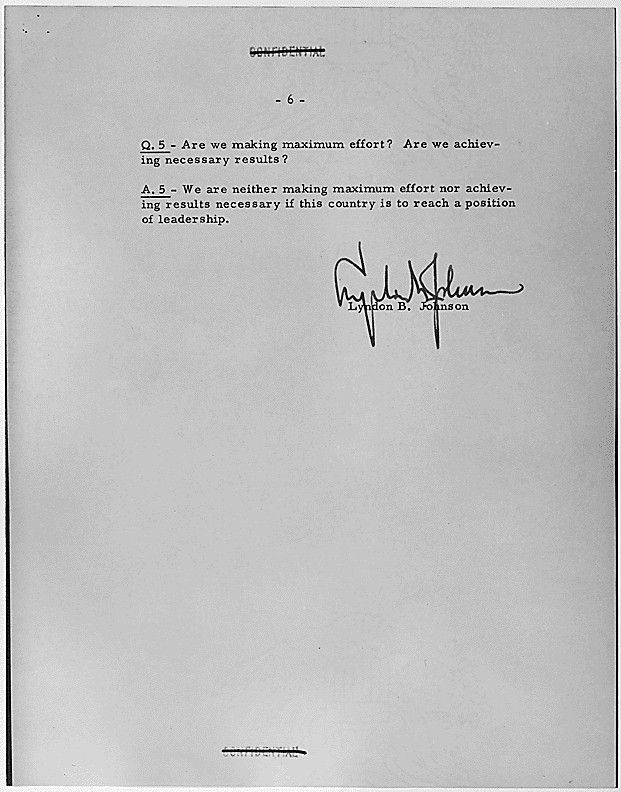
Document
Rice University Speech September 12, 1962
9/12/1963
On September 12, 1962, President John F. Kennedy delivered a speech to an audience on the Rice University campus in Houston, Texas. For approximately 18 minutes, the president discussed the nature and purpose of the nation's space program. In doing so, he acknowledged difficulties and uncertainties, but also spoke of the possibilities with great optimism. Kennedy would live only a little more than 14 months beyond the date of his speech in Houston. He would not live to see the successes of the Apollo program, nor would he witness the television broadcast of Neil Armstrong taking man's first step on the Moon in July 1969.
Text adapted from “Letters from George Washington and Samuel Cabble, and Speeches by Franklin D. Roosevelt and John F. Kennedy” in the November/December 2008 National Council for the Social Studies (NCSS) publication Social Education.
Text adapted from “Letters from George Washington and Samuel Cabble, and Speeches by Franklin D. Roosevelt and John F. Kennedy” in the November/December 2008 National Council for the Social Studies (NCSS) publication Social Education.
This primary source comes from the Collection JFK-POF: Papers of John F. Kennedy: President's Office Files.
National Archives Identifier: 193887
Full Citation: Rice University Speech September 12, 1962; 9/12/1963; Address at Rice University, Houston, Texas, 12 September 1962; Speech Files, 1961 - 1963; Collection JFK-POF: Papers of John F. Kennedy: President's Office Files, ; John F. Kennedy Library, Boston, MA. [Online Version, https://www.docsteach.org/documents/document/rice-university-speech-september-12-1962, April 19, 2024]Rice University Speech September 12, 1962
Page 1
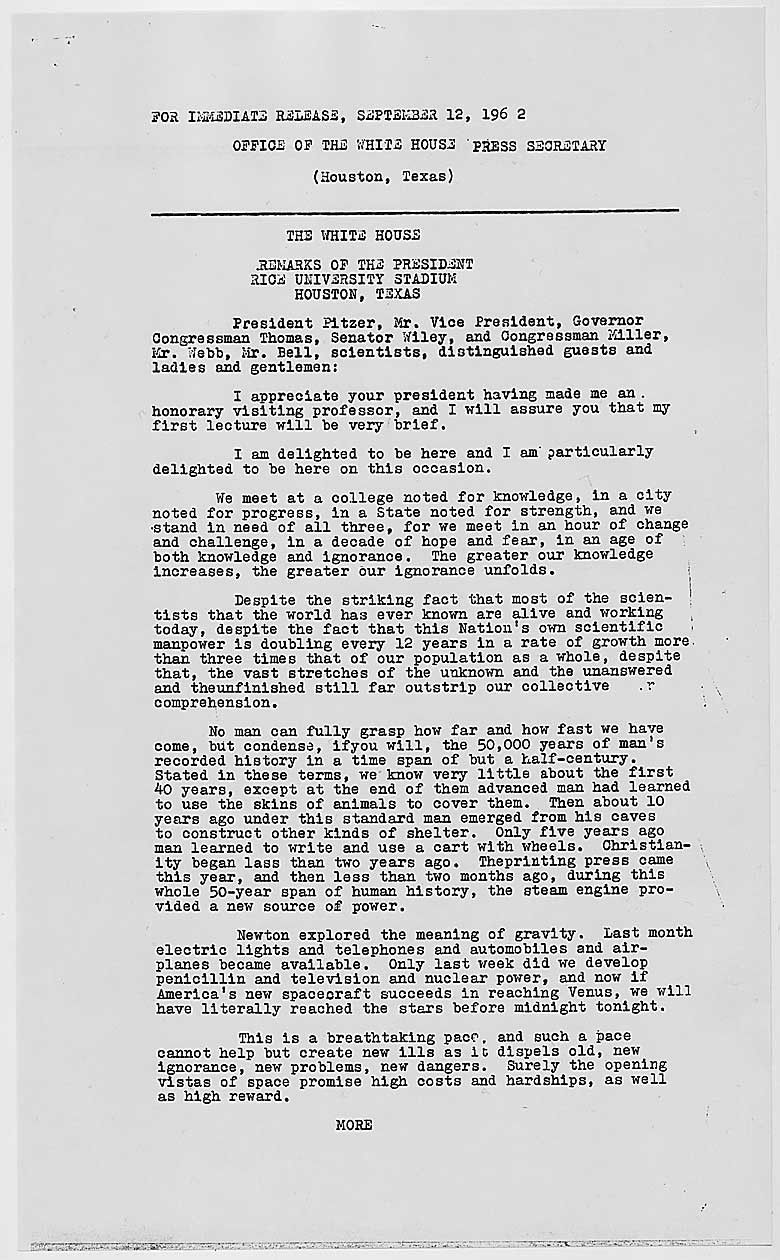
Rice University Speech September 12, 1962
Page 2

Rice University Speech September 12, 1962
Page 3
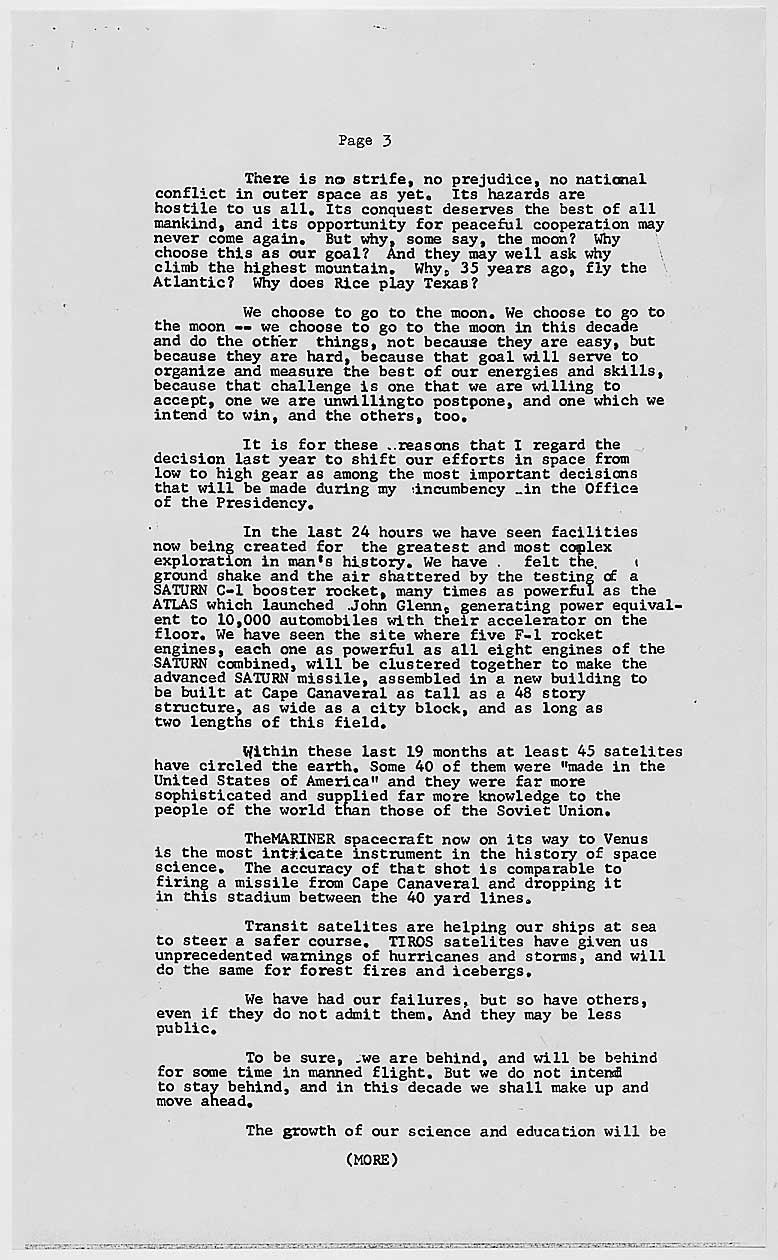
Rice University Speech September 12, 1962
Page 4

Rice University Speech September 12, 1962
Page 5
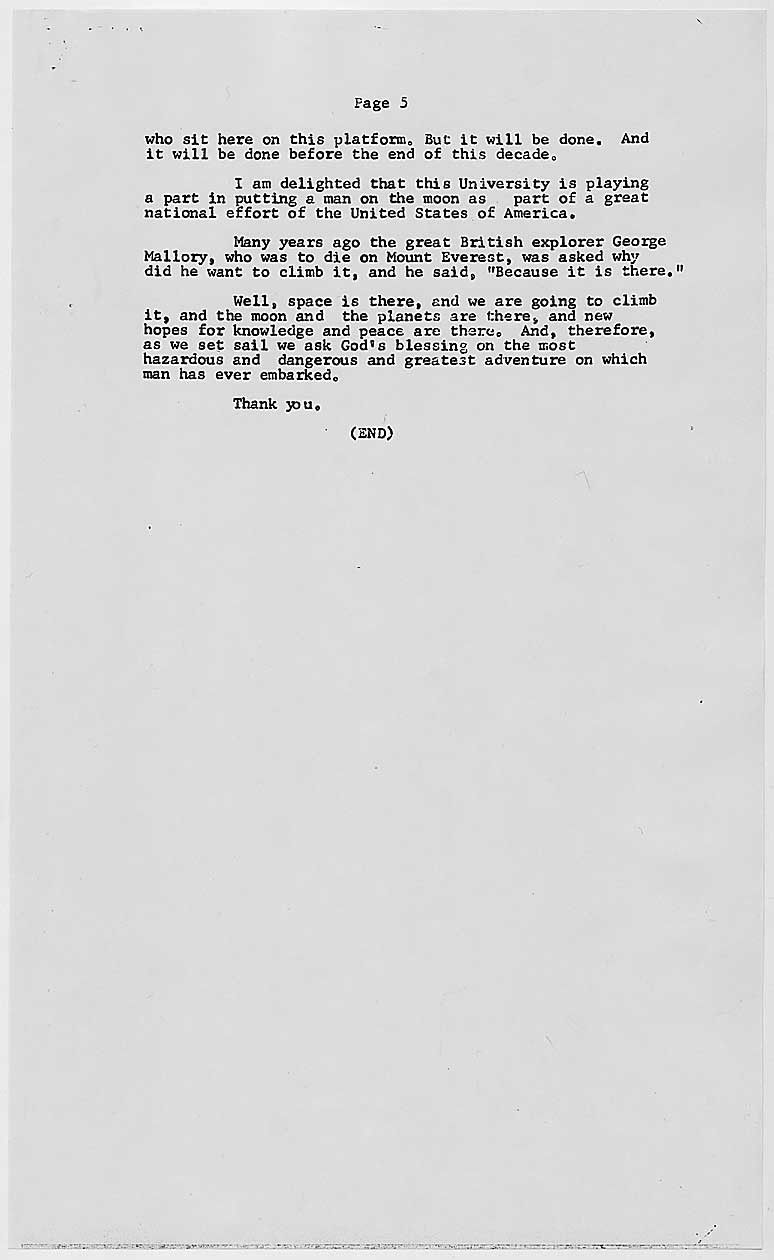
Document
Memorandum from Jim Jones to President Johnson about the Fire on Apollo 1
1/27/1967
In this memorandum, Jim Jones informs the President of the fire that kills the crew of Apollo 1. The President read the note aloud at the White House reception for Secretary of Commerce, John T. Connor. Virgil "Gus" Grissom, Roger Chaffee and Edward White died in the fire.
This primary source comes from the Collection LBJ-PJDD: President's Daily Diary.
National Archives Identifier: 2803377
Full Citation: Memorandum from Jim Jones to President Johnson about the Fire on Apollo 1; 1/27/1967; Collection LBJ-PJDD: President's Daily Diary, . [Online Version, https://www.docsteach.org/documents/document/memorandum-from-jim-jones-to-president-johnson-about-the-fire-on-apollo-1, April 19, 2024]Memorandum from Jim Jones to President Johnson about the Fire on Apollo 1
Page 1
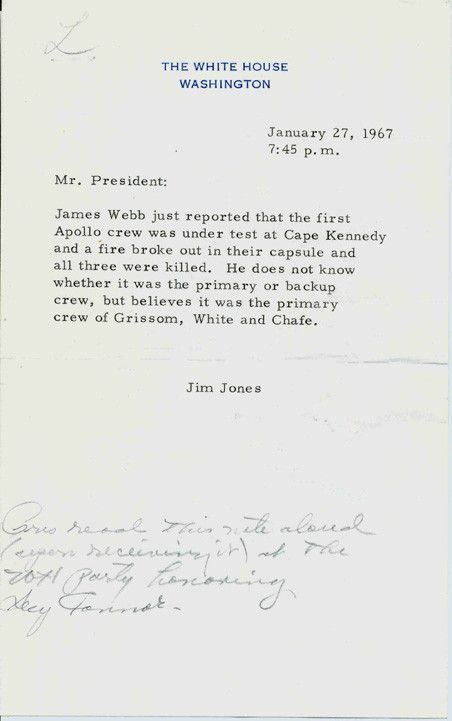
Document
Debrief: Apollo 8
1969
This film portrays man's first journey in orbit around the Moon with comments on the significance of the Apollo 8 flight by several prominent Americans. The film features photography of the lunar surface, the Earth as seen from the Moon, and the on-board activities of Astronauts Frank Borman, James "Jim" Lovell, and William "Bill" Anders. You can also watch this video in our main National Archives online catalog.
This primary source comes from the Records of the National Aeronautics and Space Administration.
National Archives Identifier: 45016
Full Citation: Motion Picture 255-HQ-188; Debrief: Apollo 8; 1969; Headquarters' Films Relating to Aeronautics, 1962 - 1981; Records of the National Aeronautics and Space Administration, ; National Archives at College Park, College Park, MD. [Online Version, https://www.docsteach.org/documents/document/debrief-apollo-8, April 19, 2024]Debrief: Apollo 8
Page 1
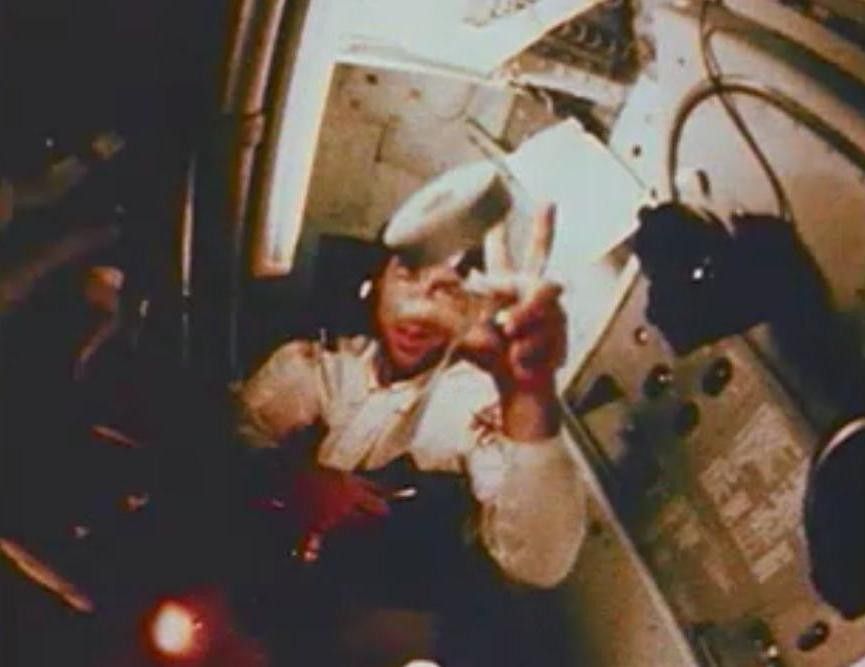
Document
Photograph of Apollo 8's View of the Moon
1968
For more information about Apollo 8 see the National Archives online exhibit Eyewitness.
This primary source comes from the Records of the National Aeronautics and Space Administration.
National Archives Identifier: 849178
Full Citation: Photograph of Apollo 8's View of the Moon; 1968; Records of the National Aeronautics and Space Administration, . [Online Version, https://www.docsteach.org/documents/document/photograph-of-apollo-8s-view-of-the-moon, April 19, 2024]Photograph of Apollo 8's View of the Moon
Page 1
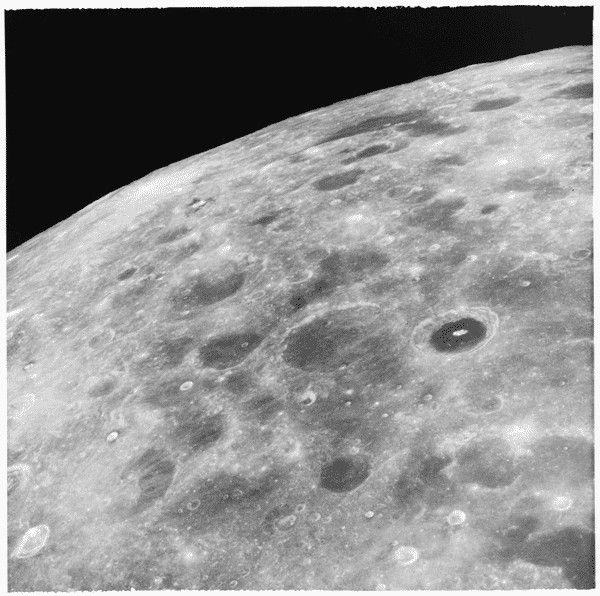
Document
Map of the Lunar Surface
1969
This item is a Lunar Surface Map that was created for the Apollo 10 mission which was essentially a “dress rehearsal” for the lunar landing which would take place with the Apollo 11 mission.
This primary source comes from the Records of the National Aeronautics and Space Administration.
National Archives Identifier: 6734363
Full Citation: Map of the Lunar Surface; 1969; Records of the National Aeronautics and Space Administration, . [Online Version, https://www.docsteach.org/documents/document/map-of-the-lunar-surface, April 19, 2024]Map of the Lunar Surface
Page 1
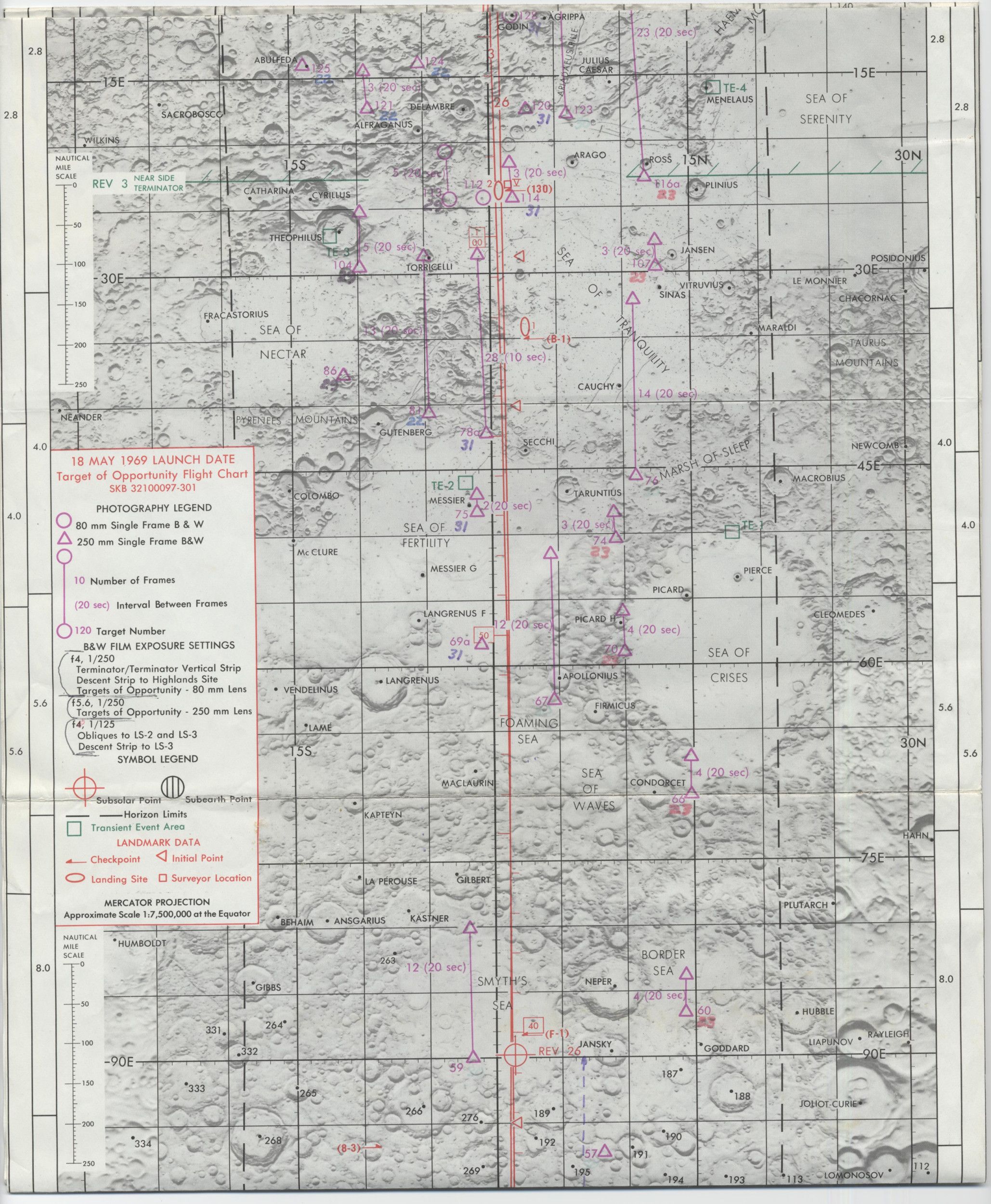
Document
Apollo 11 Flight Plan
7/1/1969
This flight plan for Apollo 11 was a minute-by-minute time line of activities for the mission crew.
This primary source comes from the Records of the National Aeronautics and Space Administration.
National Archives Identifier: 6734365
Full Citation: Apollo 11 Flight Plan; 7/1/1969; Records of the National Aeronautics and Space Administration, . [Online Version, https://www.docsteach.org/documents/document/apollo-11-flight-plan, April 19, 2024]Apollo 11 Flight Plan
Page 1
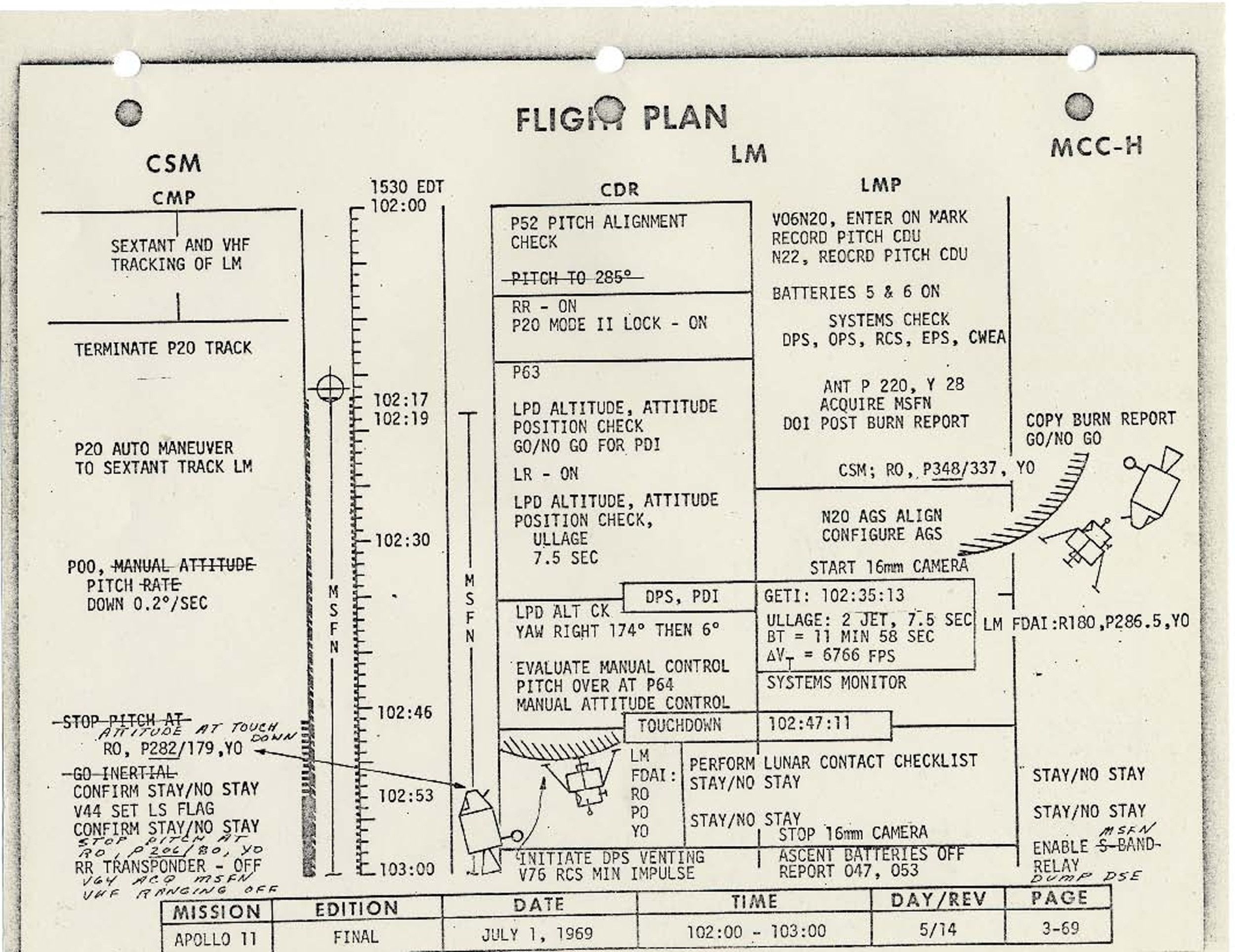
Document
Apollo 11 Target of Opportunity Flight Chart
7/20/1969
Additional details from our exhibits and publications
This lunar orbit chart was used in conjunction with the flight of Apollo 11. It represents what astronauts Neil Armstrong and Buzz Aldrin would see on one complete revolution. Prominent features were marked to assist their navigation.
This primary source comes from the Records of the National Aeronautics and Space Administration.
National Archives Identifier: 1687943
Full Citation: Apollo 11 Target of Opportunity Flight Chart; 7/20/1969; Records of the National Aeronautics and Space Administration, . [Online Version, https://www.docsteach.org/documents/document/apollo-11-target-of-opportunity-flight-chart, April 19, 2024]Apollo 11 Target of Opportunity Flight Chart
Page 1
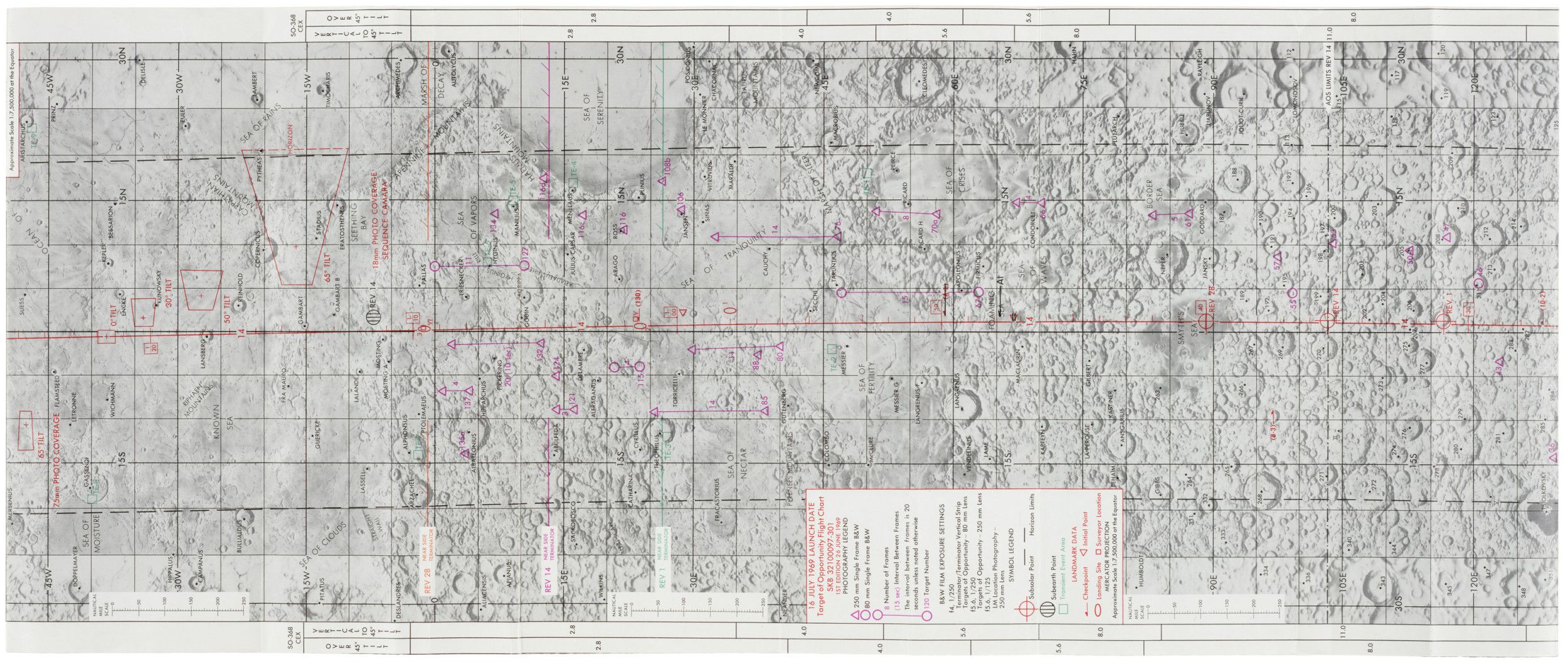
Apollo 11 Target of Opportunity Flight Chart
Page 2
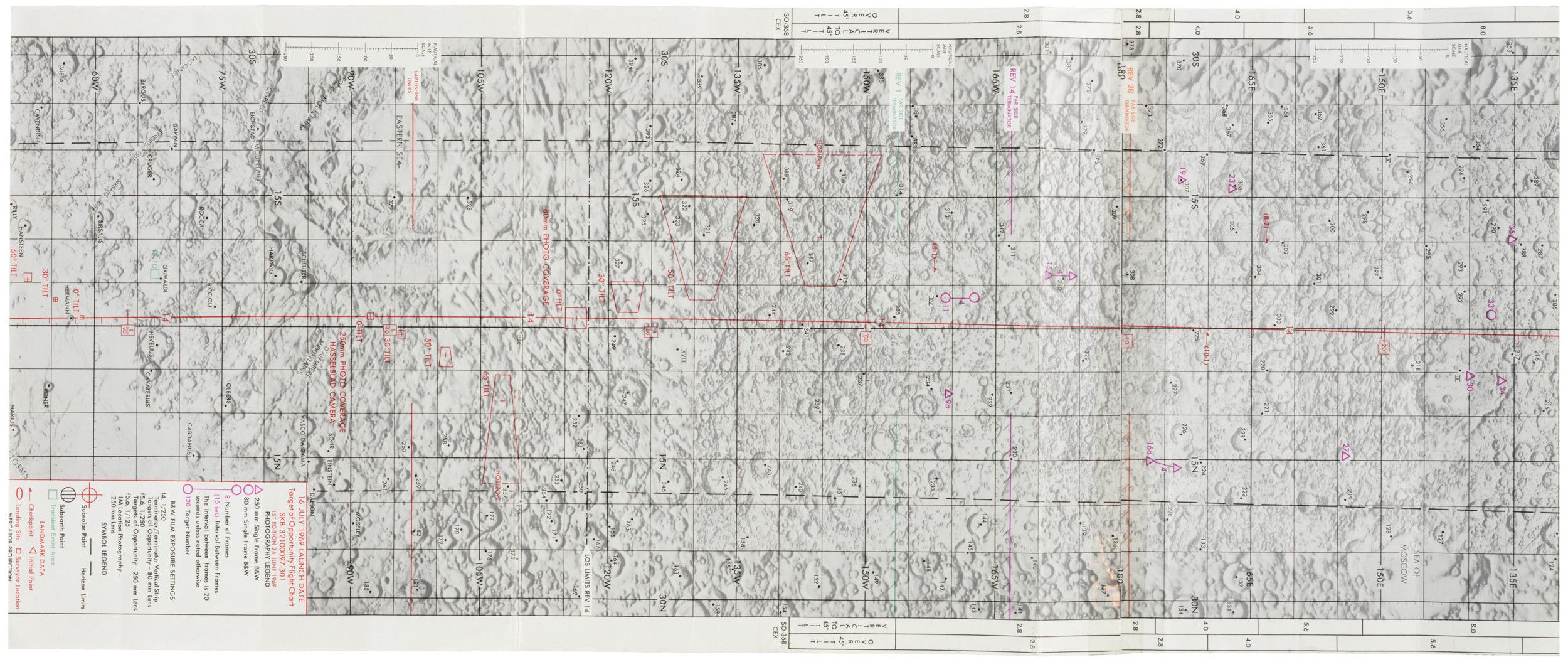
Document
Photograph of Astronaut Edwin E. (Buzz) Aldrin, Jr. Posing on the Moon Next to the U.S. Flag
7/20/1969
Additional details from our exhibits and publications
Apollo 11 Astronaut Edwin E. (Buzz) Aldrin, Jr., posed on the surface of the Moon next to the U.S. flag on July 20, 1969. The second man ever to walk on the Moon, Aldrin, along with mission commander Neil A. Armstrong, erected the flag, took photographs, collected rock samples, and experimented with moving under gravity one-sixth that of Earth’s.
This primary source comes from the Records of the U.S. Information Agency.
National Archives Identifier: 593743
Full Citation: Photograph of Astronaut Edwin E. (Buzz) Aldrin, Jr. Posing on the Moon Next to the U.S. Flag; 7/20/1969; Records of the U.S. Information Agency, . [Online Version, https://www.docsteach.org/documents/document/photograph-of-astronaut-edwin-e-buzz-aldrin-jr-posing-on-the-moon-next-to-the-us-flag, April 19, 2024]Photograph of Astronaut Edwin E. (Buzz) Aldrin, Jr. Posing on the Moon Next to the U.S. Flag
Page 1
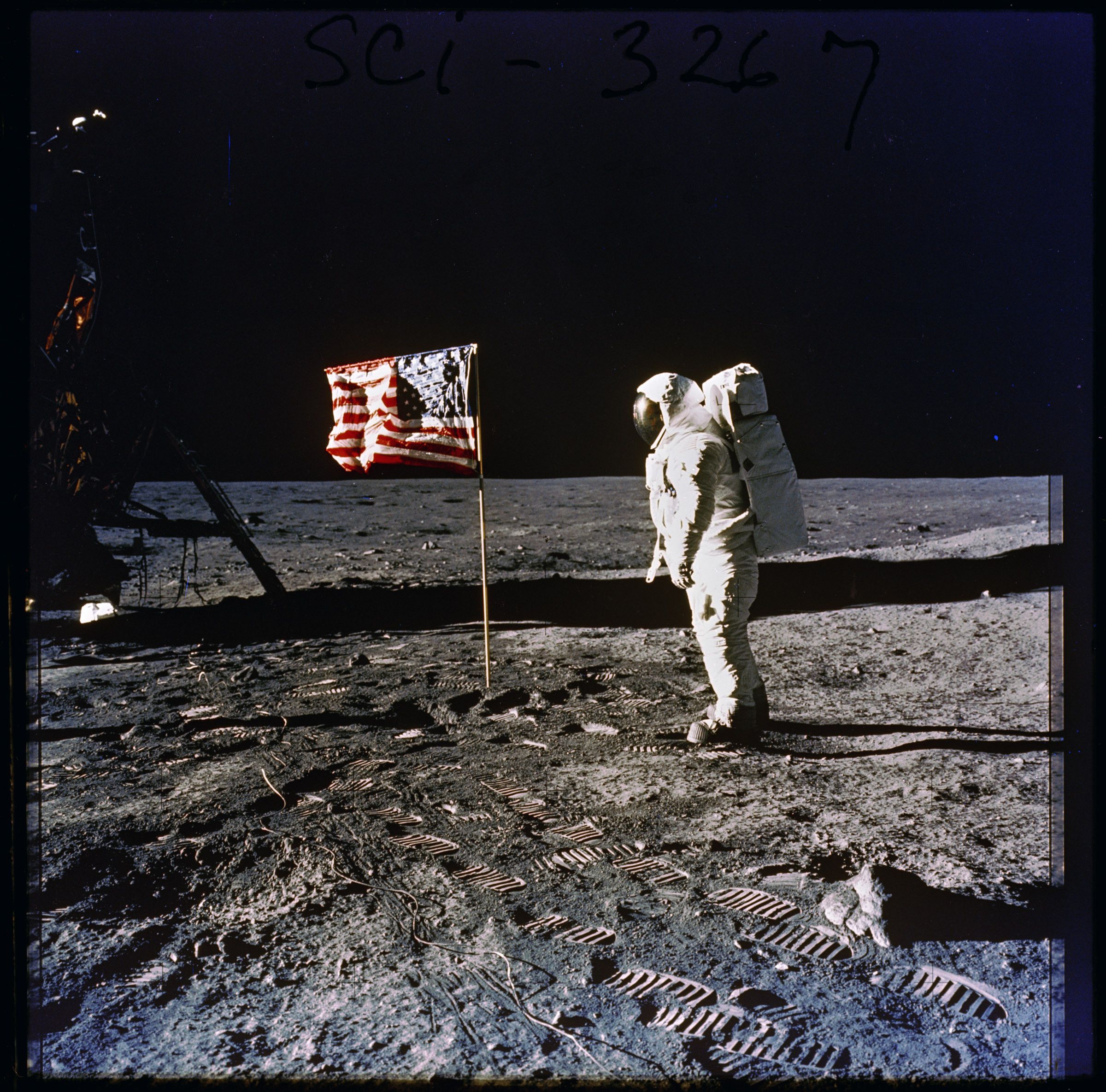
Document
Presidential Daily Diary Entry
7/20/1969
President Richard Nixon’s daily diary shows a busy evening on July 20, 1969. Nixon’s last phone call took place at 11:45 P.M. It was an "interplanetary conversation" with astronauts Neil Armstrong and "Buzz" Aldrin, from the moon. During the conversation Armstrong said: "It’s a great honor and privilege for us to be here representing not only the United States but men of peace of all nations."
This primary source comes from the Collection RN-OPP: Records of the Office of Presidential Papers.
National Archives Identifier: 595079
Full Citation: Presidential Daily Diary Entry; 7/20/1969; July 16, 1969-July 31, 1969; Presidential Daily Diary, 1/21/1969 - 8/9/1974; Collection RN-OPP: Records of the Office of Presidential Papers, . [Online Version, https://www.docsteach.org/documents/document/presidential-daily-diary-entry, April 19, 2024]Presidential Daily Diary Entry
Page 1

Document
Richard M. Nixon on the Phone in the Oval Office Talking to Astronauts on the Moon
7/21/1969
This photograph shows President Richard M. Nixon talking on the phone to astronaunts on the moon from the Oval Office at the White House.
This primary source comes from the Collection RN-WHPO: White House Photo Office Collection (Nixon Administration).
National Archives Identifier: 194648
Full Citation: Photograph WHPO-MPF-1602(01); Richard M. Nixon on the Phone in the Oval Office Talking to Astronauts on the Moon; 7/21/1969; Nixon White House Photographs, 1/20/1969 - 8/9/1974; Collection RN-WHPO: White House Photo Office Collection (Nixon Administration), ; Richard Nixon Library, Yorba Linda, CA. [Online Version, https://www.docsteach.org/documents/document/nixon-phone-astronauts, April 19, 2024]Richard M. Nixon on the Phone in the Oval Office Talking to Astronauts on the Moon
Page 1
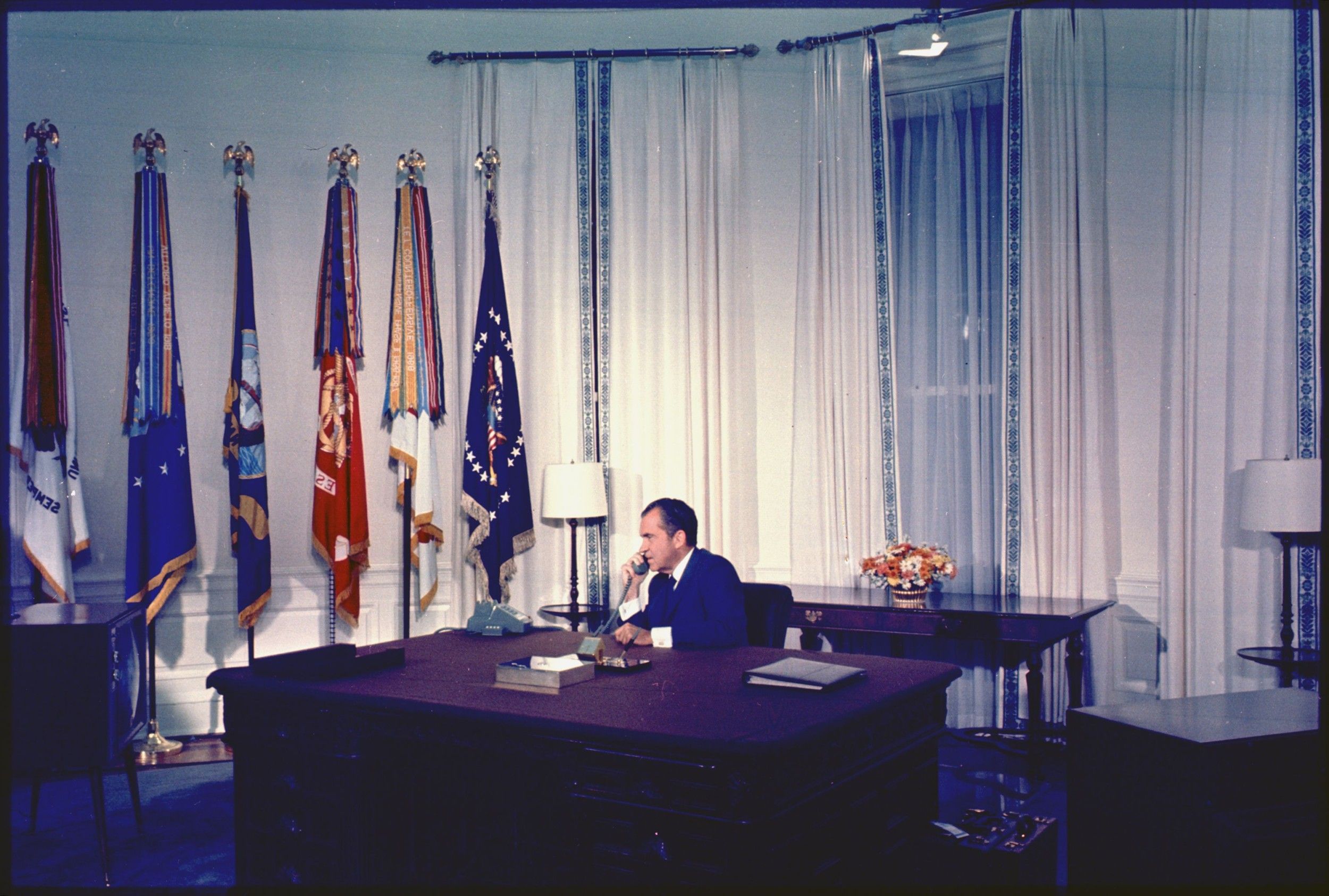
Document
Letter from Thaddeus A. Zagorewicz to President Richard Nixon
7/20/1969
Thaddeus A. Zagorewicz of San Francisco sent this letter to President Richard Nixon. Zagorewicz expressed his interest in moon exploration and congratulations regarding the astronauts' first moon walk on July 20, 1969.
Additional details from our exhibits and publications
American citizens celebrated the Moon landing in many different ways—by holding Moon parties, by taking photographs, or, in the case of Thaddeus A. Zagorewicz, by writing a letter of congratulations to President Richard Nixon. After watching the landing with his family, Zagorewicz was moved to conclude that they were “very proud to be American citizens.”
This primary source comes from the Collection RN-WHAN: White House Alpha (Alphabetical) Name Files (Nixon Administration).
National Archives Identifier: 594978
Full Citation: Letter from Thaddeus A. Zagorewicz to President Richard Nixon; 7/20/1969; Zagor; White House Alpha (Alphabetical) Name Files, 1969 - 1974; Collection RN-WHAN: White House Alpha (Alphabetical) Name Files (Nixon Administration), ; Richard Nixon Library, Yorba Linda, CA. [Online Version, https://www.docsteach.org/documents/document/zagorewicz-nixon, April 19, 2024]Letter from Thaddeus A. Zagorewicz to President Richard Nixon
Page 1
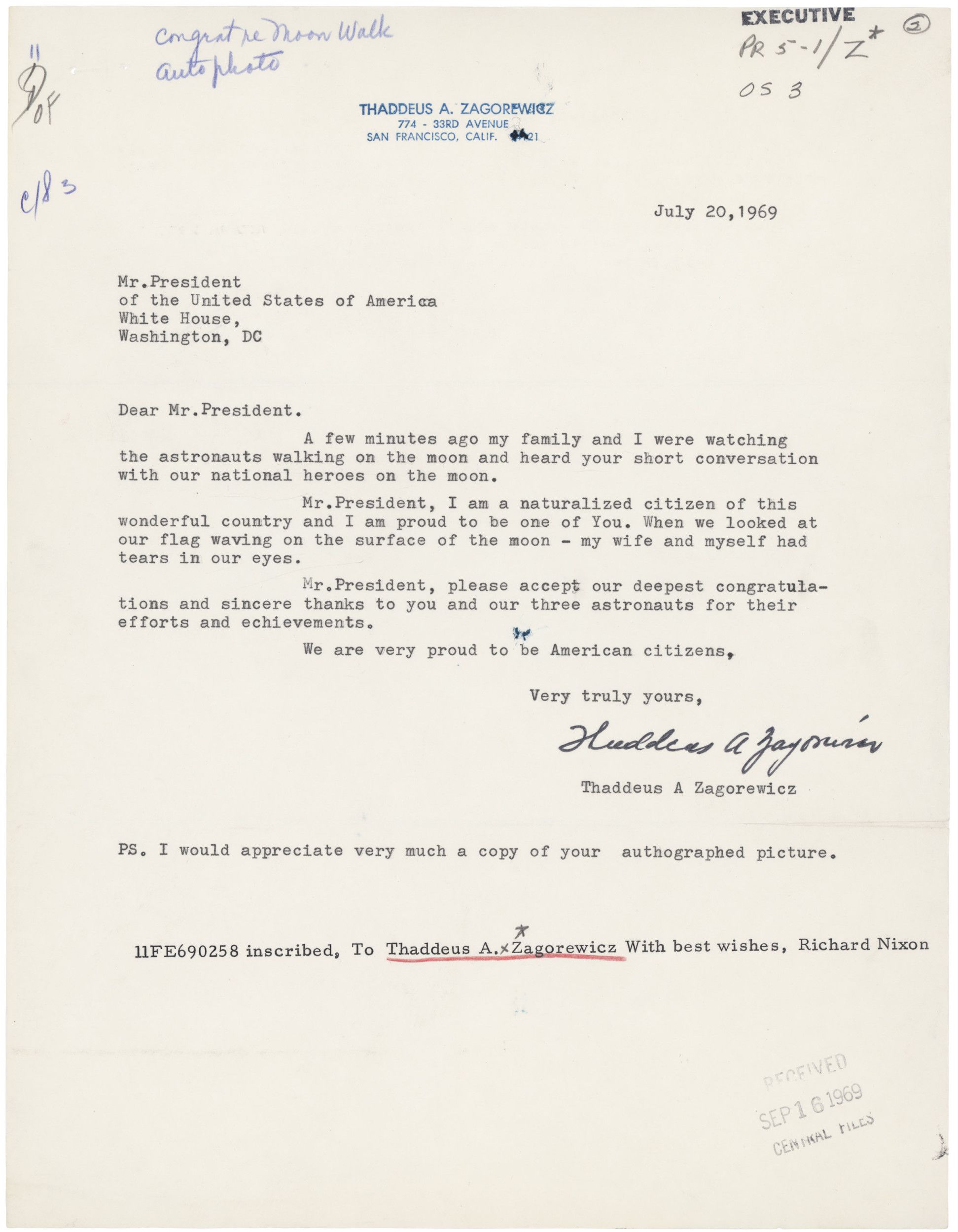
Document
Postcard with Apollo 11 Commemorative First Day Issue Stamp and Signatures
1969
This memento, sold by the U.S. Postal Service, carries a 10-cent airmail stamp with first day of issue cancellations. Signed by President Richard Nixon and astronauts Armstrong, Collins, and Aldrin, this card has a description of the landing site, Armstrong’s famous quote, and a photograph of an astronaut on the Moon with the U.S. flag on the reverse. The die for this stamp and the canceling device made the 500,000-mile journey with the astronauts.
This primary source comes from the Collection RN-SMOF: White House Staff Member and Office Files (Nixon Administration).
National Archives Identifier: 1634230
Full Citation: Postcard with Apollo 11 Commemorative First Day Issue Stamp and Signatures ; 1969; Collection RN-SMOF: White House Staff Member and Office Files (Nixon Administration), . [Online Version, https://www.docsteach.org/documents/document/postcard-with-apollo-11-commemorative-first-day-issue-stamp-and-signatures, April 19, 2024]Postcard with Apollo 11 Commemorative First Day Issue Stamp and Signatures
Page 1
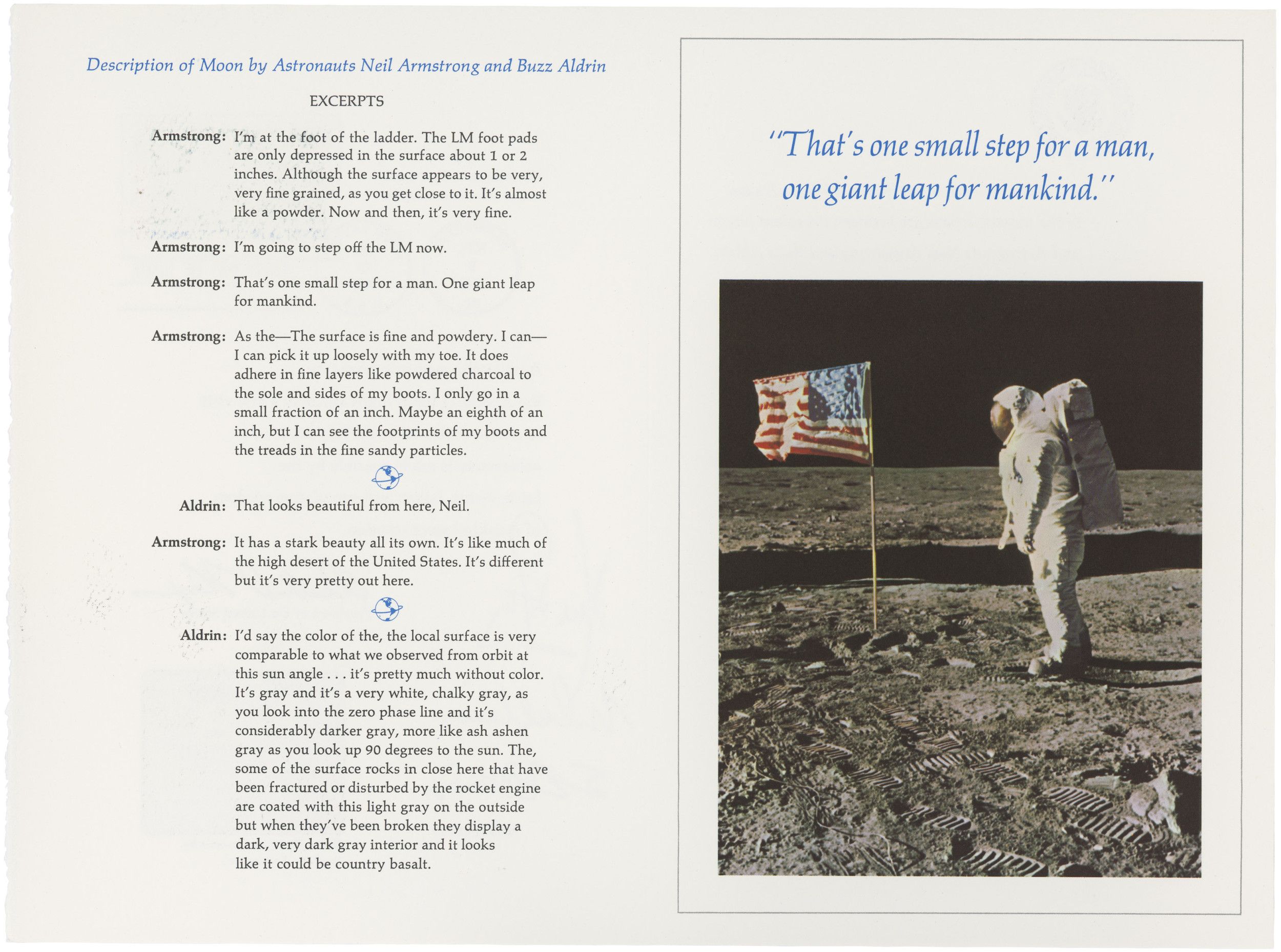
Postcard with Apollo 11 Commemorative First Day Issue Stamp and Signatures
Page 2
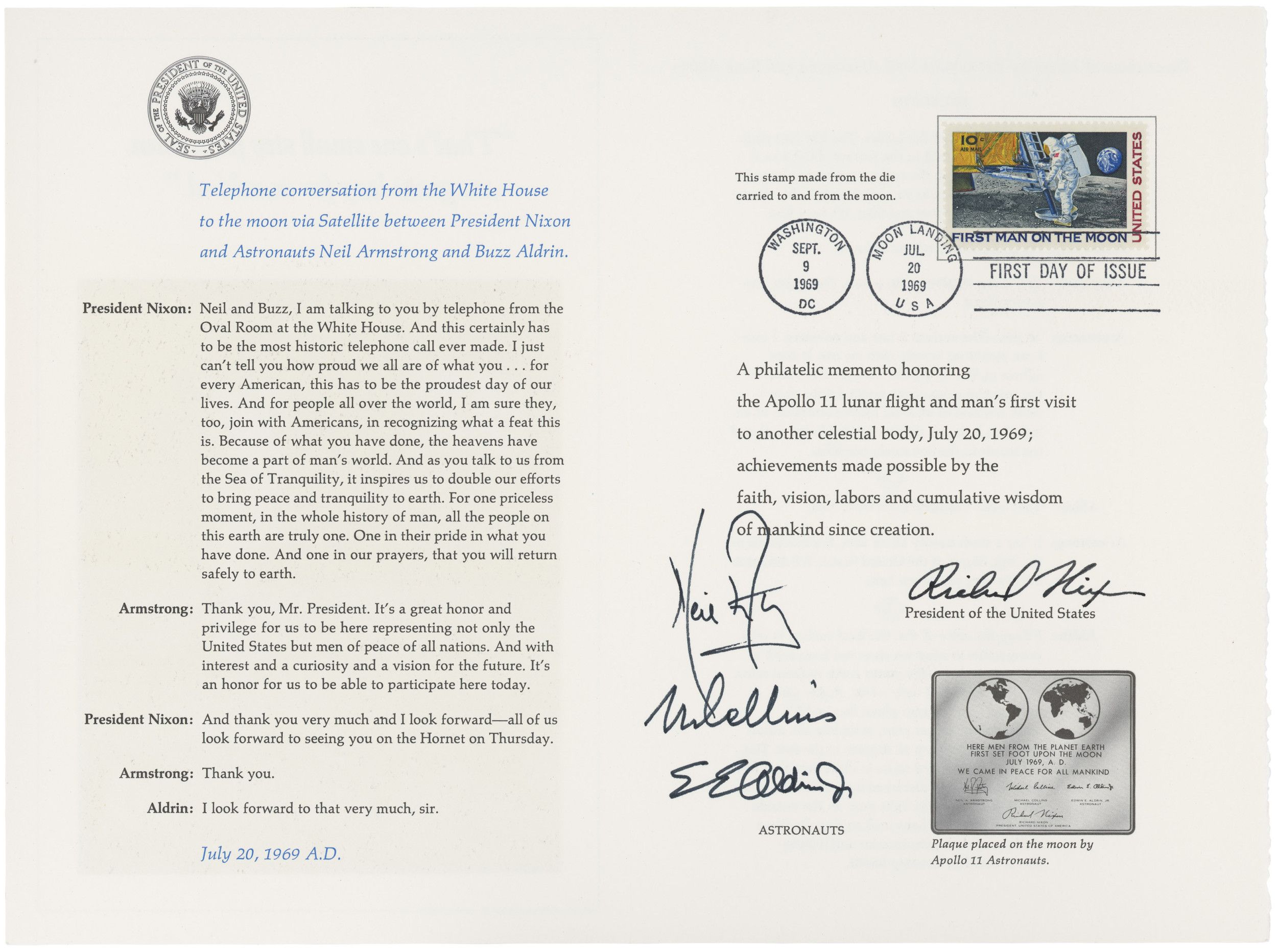
Document
S. 2709 Authorizing the Erection of a Statue to Commemorate the Manned Lunar Landing and the Placing of the United States Flag on the Moon
7/29/1969
Additional details from our exhibits and publications
Following the recovery of the Apollo 11 astronauts, Texas Senator John Tower introduced one of many bills to recognize the achievements of Armstrong, Aldrin, and Collins. This bill would have authorized the creation of a statue to commemorate the Moon landing. The bill was referred to the Committee on Interior and Insular Affairs. Congress did not enact this bill.
This primary source comes from the Records of the U.S. Senate.
National Archives Identifier: 1634183
Full Citation: S. 2709 Authorizing the Erection of a Statue to Commemorate the Manned Lunar Landing and the Placing of the United States Flag on the Moon; 7/29/1969; Records of the U.S. Senate, . [Online Version, https://www.docsteach.org/documents/document/s-2709-authorizing-the-erection-of-a-statue-to-commemorate-the-manned-lunar-landing-and-the-placing-of-the-united-states-flag-on-the-moon, April 19, 2024]S. 2709 Authorizing the Erection of a Statue to Commemorate the Manned Lunar Landing and the Placing of the United States Flag on the Moon
Page 1
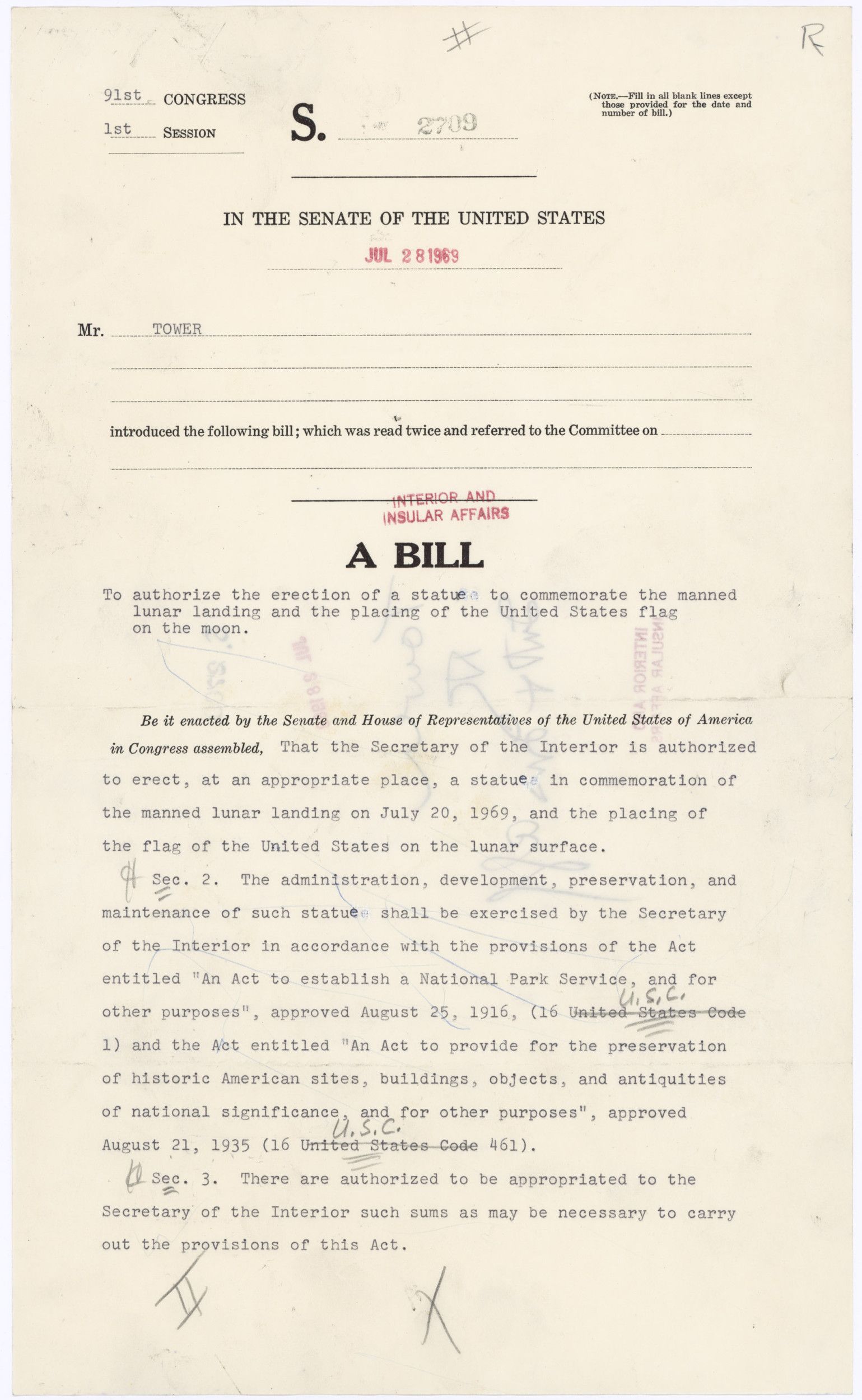
Document
Earth, as Seen by Astronauts Eugen Cernan, Ronald Evans and Harrison Schmidt from Apollo 17
12/1972
This primary source comes from the Records of the Environmental Protection Agency.
National Archives Identifier: 553803
Full Citation: Earth, as Seen by Astronauts Eugen Cernan, Ronald Evans and Harrison Schmidt from Apollo 17; 12/1972; Records of the Environmental Protection Agency, . [Online Version, https://www.docsteach.org/documents/document/earth-as-seen-by-astronauts-eugen-cernan-ronald-evans-and-harrison-schmidt-from-apollo-17, April 19, 2024]Earth, as Seen by Astronauts Eugen Cernan, Ronald Evans and Harrison Schmidt from Apollo 17
Page 1
